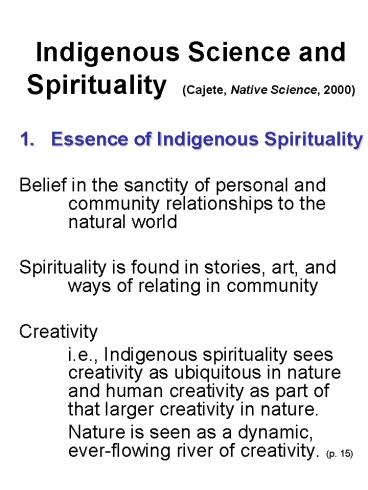Indigenous Science and Spirituality (Cajete, Native Science, 2000) - PowerPoint PPT Presentation
1 / 6
Title:
Indigenous Science and Spirituality (Cajete, Native Science, 2000)
Description:
Indigenous Science and Spirituality (Cajete, Native Science, 2000) 1. Essence of Indigenous Spirituality Belief in the sanctity of personal and community ... – PowerPoint PPT presentation
Number of Views:122
Avg rating:3.0/5.0
Title: Indigenous Science and Spirituality (Cajete, Native Science, 2000)
1
Indigenous Science and Spirituality (Cajete,
Native Science, 2000)
- 1. Essence of Indigenous Spirituality
- Belief in the sanctity of personal and community
relationships to the natural world - Spirituality is found in stories, art, and ways
of relating in community - Creativity
- i.e., Indigenous spirituality sees creativity
as ubiquitous in nature and human creativity as
part of that larger creativity in nature. - Nature is seen as a dynamic, ever-flowing river
of creativity. (p. 15)
2
2. Some Principles of Native Science and
Spirituality
- Engagement and Receptivity
- Respectful and Caring Relationship to The Land
- Animism Everything in nature, even things
like rocks that western science regards as
inanimate, is active and has its own energy and
its own unique intelligence and creative
process. - Harmonious Relationships
- Intersubjectivity
- Participation.
3
3. Indigenous Creation Myths
- Tend to emphasize human participation with the
creative forces of the universe - Involve a natural democracy (equality) whereby
humans are not privileged as dominant over other
beings. - Often involve humans moving through stages
(evolution / journey - Humans are often seen as co-creators, but no more
important than other co-creators - Often involve the trickster (e.g., raven or
coyote) or the cultural hero, who are
intelligent, possesses supernatural powers, and
are often 2-sided - Often involve rather fluid lines between humans
and other animals, - as each could
- transform into the
- other.
4
4. Vehicles for Transmitting / Accessing
Indigenous Scientific Knowledge
- Ceremonies
- Vision quests
- c) Myths and Stories
5
5. Indigenous Art General Introduction
- The Indig artist selects the features that are
the essence and vitality of the phenomenon being
portrayed, and expresses those features in the
chosen medium. - Thus, the aliveness of the artefact, rather
than its beauty, is the primary aesthetic
criterion. - has a ceremonial dimension that is sacred and
transforms the artist at the very core of his
being (p. 46.) Thus, the process of making
the art is much more important than the product. - Apprenticeship is the primary means for learning
a particular art form.
6
6. The Essential Cosmological Clash
- What is Cosmology? - deep-rooted
understandings of human-ness and our place in
the universe. - What is The Essential Cosmological Clash
? between egalitarian Indigenous
worldviews that regard all things as
having rights, - and the hierarchical western notion that
humans have a special place in the
universe that gives us rights (dominion)
over and above other parts of Creation. - Dysfunctionality Crisis of W. Cosmology































